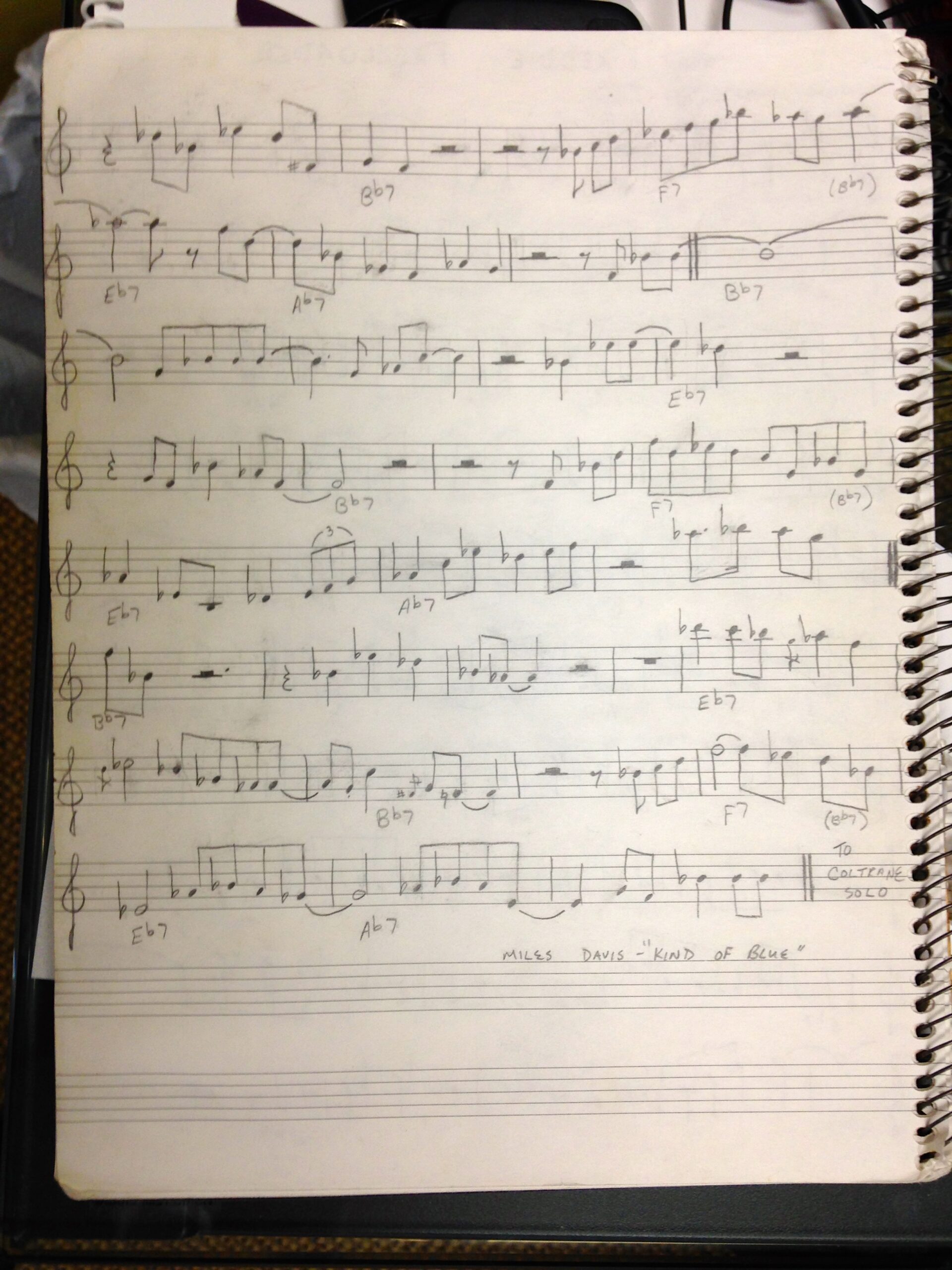Many students are intimidated by the idea of transcribing music. However for most students, transcription is something you’re probably already doing on one level or another – you just may not realize it. Are you interested in learning more about practicing and developing the skill of transcription? We’re preparing some lessons on the skill of transcription, so leave us a comment and tell us your thoughts and what you’d like to see.
One of my private students has been transcribing solos from Miles Davis’ classic record Kind of Blue. Specifically he’s been working on the various solos within the tune “Freddie Freeloader.” I chose this album for him to begin his transcription experience not simply because it’s a landmark jazz album, but because it contains so much quintessential jazz language played by the jazz masters – Cannonball, Coltrane, Miles, Bill Evans, Wynton Kelly, Paul Chambers, and Jimmy Cobb. Also, it was one of the first real transcription assignments I had been given by my teacher when I got to college. He basically told me “you have to learn everything on this record, so let’s get started,” and proceeded to assign me a couple choruses a week from various tunes off the record. Discovering transcription marked a period of tremendous growth in my playing, confidence, and musical aptitude.
I had never really transcribed before I got to college. By that I mean, I had never been given an assignment where someone told me to listen to something, figure it out verbatim, be able to play it in time with the record, and faithfully notate it. I had played in my high school jazz band and done some pop/rock gigs, so I was accustomed to figuring things out by ear, but I had never really been intent on getting as close to the original as possible. So I was a little overwhelmed (I felt that way a lot as a college freshman pursuing a Piano Performance degree) but I got into the practice room, put on the headphones, and started figuring out the solo I’d been assigned, one note at a time. Fast forward a couple years and I had notebooks full of transcriptions. Not only did I like transcribing because of the musical skills it cultivated, but I also liked filling my notebooks with solos I’d figured out, cataloging all the various language I’d deciphered, and watching my collection grow. It was like I had figured out how to look inside the brains of these musicians I idolized, discovering what Keith Jarrett and Joshua Redman and Michael Brecker thought about when improvising over the same tunes I wanted to play.
Oh yeah, and I stole all the good licks, too! That’s right, if I heard something I liked I highlighted it, transposed it to a bunch of different keys, and tried to force it into every solo I took. I had a separate notebook full of licks that I extracted from complete solos I had transcribed (I especially liked ii-V-I licks because I could use them right away in my own “improvisations”). And I was not shy about cramming all those licks into as many solos as possible, as often as possible, figuring that was the quickest way to make them a natural part of my jazz vocabulary. For a little while my idea of “taking a solo” was just that – taking the licks of others and weaving them together to create a patchwork solo. But it taught me a lot. It taught me that copying (what I’m playfully referring to as “stealing”) is an important part of developing your own ability to use the jazz language. It’s really not that much different from how we learn to speak as children, by copying the sounds of the adults around us. My advice for students who want to improve their jazz improvisation language? Copy the musical things that sound good to you.
So last night, after a full day of teaching, I drove to my mom’s house to visit and have dinner (what a good son, right?). I was still thinking about my student embarking on his first transcription assignments, and about my notebooks from college filled with all the solos I had transcribed. I hadn’t seen those notebooks in years. “What did I do with them? Where are they now? How could I have lost those things?” Over dinner, on a whim, I asked my mother if she’d seen any black music notebooks in her cleanings (now that all her children have moved out she’s often re-purposing our old bedrooms). I didn’t expect she’d have a clue as to what I was referring to, but my mother continues to surprise me. “I put all your music stuff in a box under your bed in your old room,” she said. And lo and behold, I was reunited with my old transcription notebooks (some of them, anyway). Thank you, mom, for not throwing them away.
And in celebration of this momentous reunion, I’d like to share one of my transcriptions with you. It’s a great solo to learn and analyze for any jazz student – Miles Davis’ solo on “Freddie Freeloader” from the Kind of Blue album – complete with smudgy pencil markings, a couple strangely-written rhythmic figures, and some obvious confusion as to where chord symbols should be written (Beware! I wrote them underneath the staff – it was my first transcription, I had a few things to learn). Enjoy!



